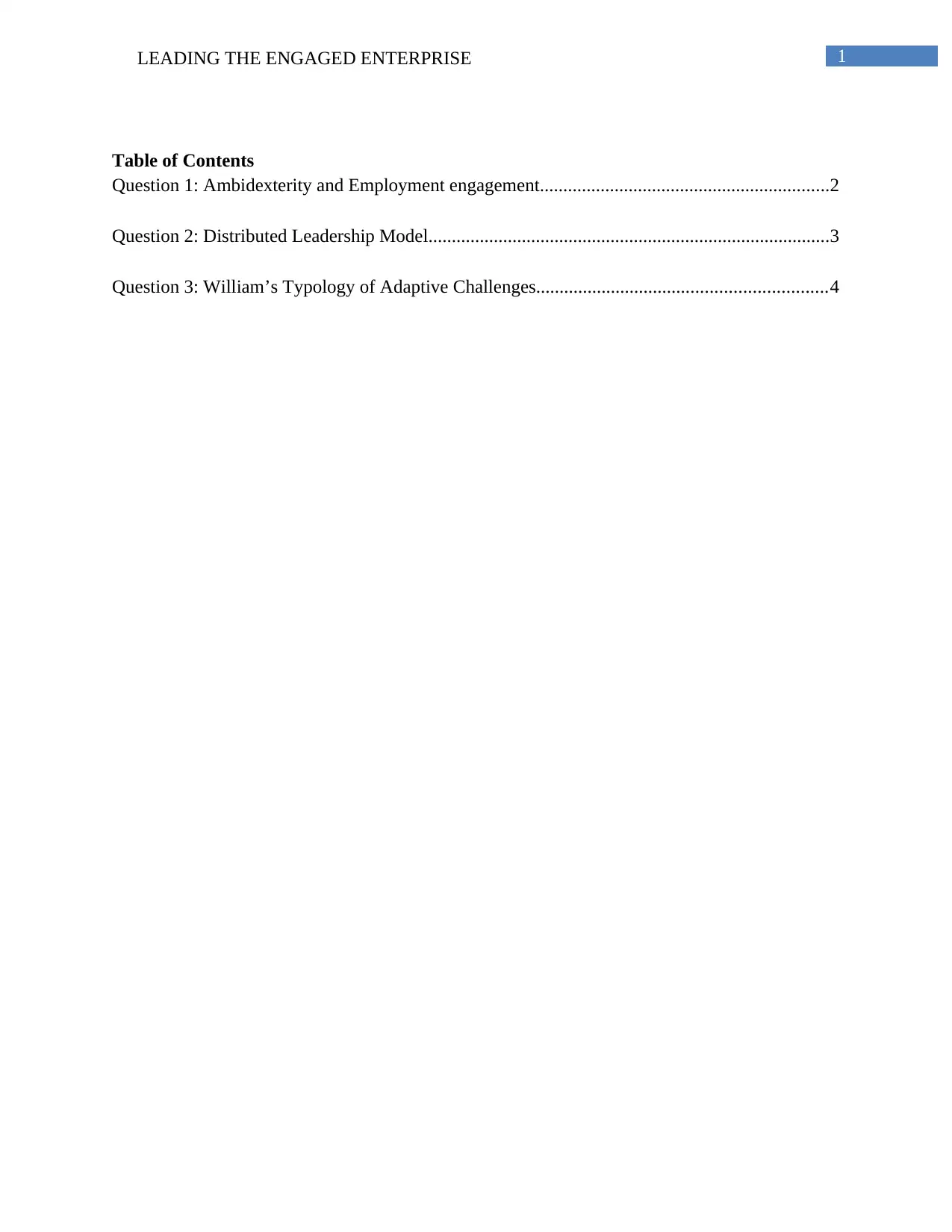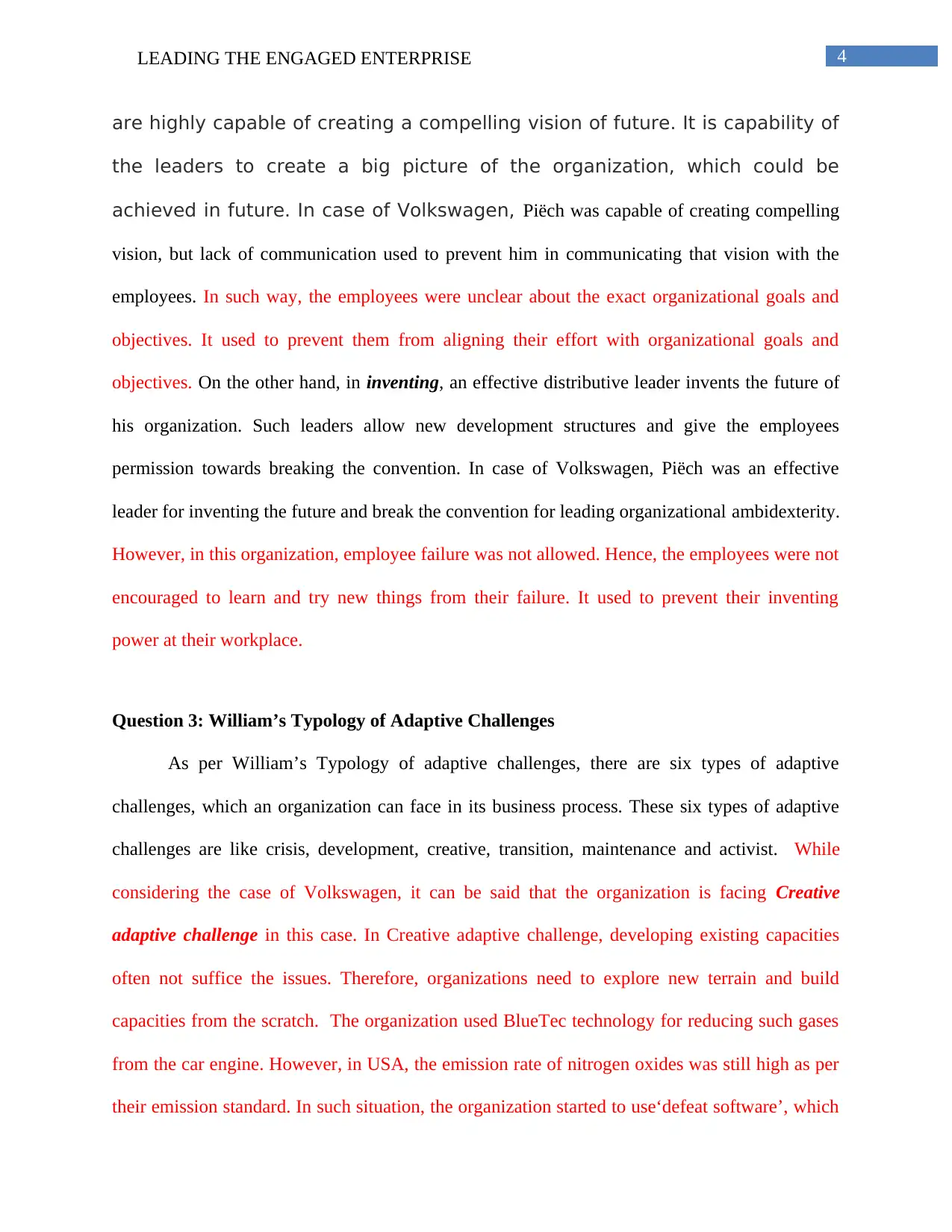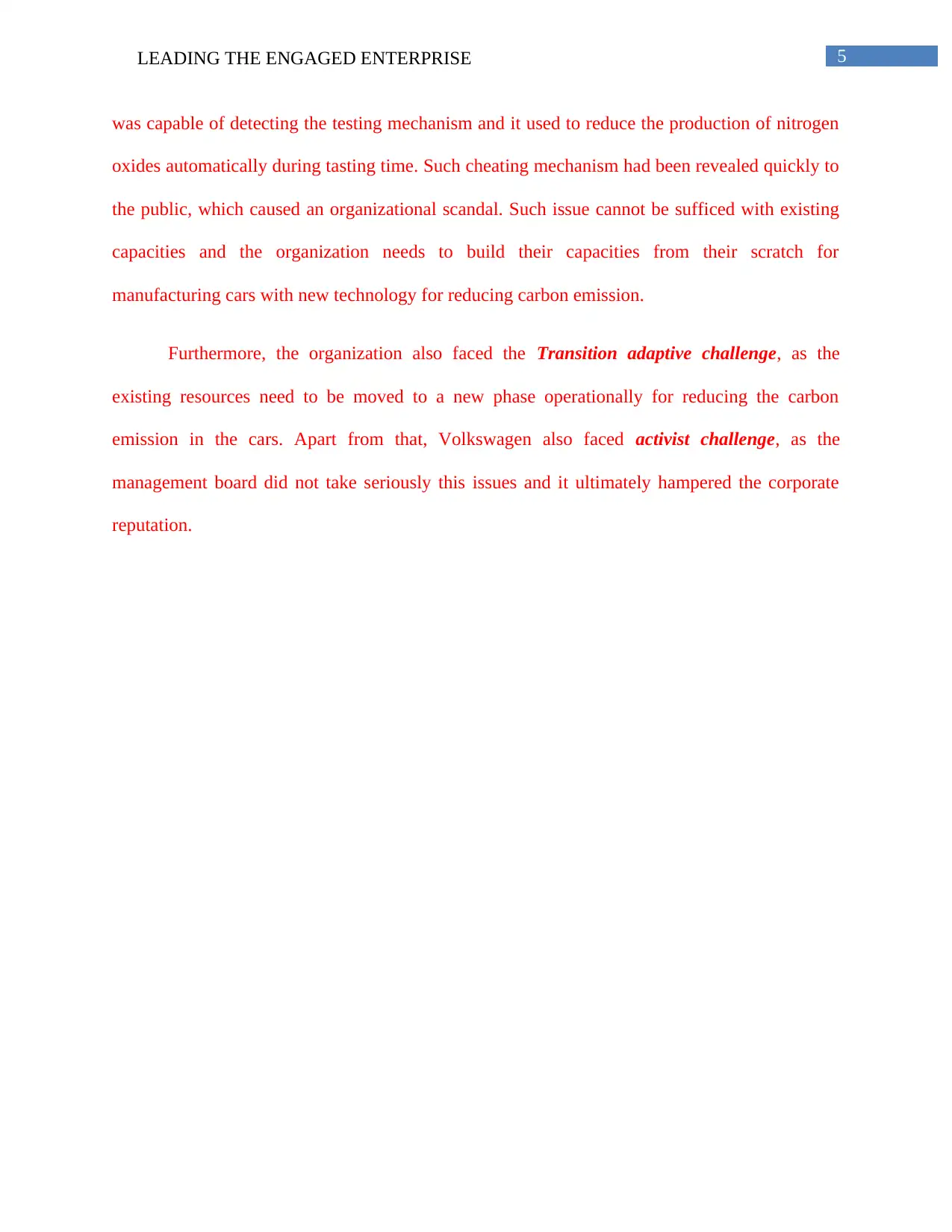Leading the Engaged Enterprise: Volkswagen Case Study Report
VerifiedAdded on 2020/04/21
|6
|1059
|218
Report
AI Summary
This report analyzes Volkswagen's leadership practices, focusing on employee engagement and organizational ambidexterity. It examines the application of the distributed leadership model, evaluating its strengths and weaknesses in the context of Volkswagen's leadership structure. The report also delves into William's Typology of Adaptive Challenges, specifically addressing the creative and transition challenges faced by Volkswagen, particularly concerning the emissions scandal. The analysis considers the impact of leadership styles on employee empowerment, communication, and the organization's ability to adapt to changing business environments. The report highlights the importance of fostering employee engagement and addressing adaptive challenges to achieve organizational success. The report provides valuable insights into the complexities of leadership, employee engagement, and organizational adaptability within the automotive industry, using Volkswagen as a case study.

Running head: LEADING THE ENGAGED ENTERPRISE
Leading the Engaged Enterprise
Name of the Student:
Name of the University:
Author’s Note:
Leading the Engaged Enterprise
Name of the Student:
Name of the University:
Author’s Note:
Paraphrase This Document
Need a fresh take? Get an instant paraphrase of this document with our AI Paraphraser

1LEADING THE ENGAGED ENTERPRISE
Table of Contents
Question 1: Ambidexterity and Employment engagement..............................................................2
Question 2: Distributed Leadership Model......................................................................................3
Question 3: William’s Typology of Adaptive Challenges..............................................................4
Table of Contents
Question 1: Ambidexterity and Employment engagement..............................................................2
Question 2: Distributed Leadership Model......................................................................................3
Question 3: William’s Typology of Adaptive Challenges..............................................................4

2LEADING THE ENGAGED ENTERPRISE
Question 1: Ambidexterity and Employment engagement
Organizational ambidexterity refers to the ability of an organization to be efficient in
today’s business as well as adapting and coping up with the future changing demands. Moreover,
ambidextrous organizations are highly capable of exploiting the existing
competencies, while simultaneously exploiting new business opportunities
for the business. While considering the case of Volkswagen, it can be seen
that the organization is highly capable of using its superior engineers and
technologists for making luxurious and comfortable cars. Moreover, the
organization is capable enough to beat the top automakers of the world like
General Motors and Toyota. Furthermore, the organization is also intended to
manufacture environment friendly cars powered by diesel engine. In this
way, the organization would the future environmental protection needs of
the world. Therefore, Volkswagen can be considered as an ambidextrous
organization in car making industry.
Employee engagement is mostly based on the trust, integrity and two way commitments
between employers and the employees, which ensures that the employees are treated in a right
manner within their workplace. While considering the case of Volkswagen, it can be said
that there is lack of employee engagement in their workplace. Moreover, the
employees are not provided with enough empowerment for doing their jobs.
Therefore, such employees were not highly engaged in their workplace.
Question 1: Ambidexterity and Employment engagement
Organizational ambidexterity refers to the ability of an organization to be efficient in
today’s business as well as adapting and coping up with the future changing demands. Moreover,
ambidextrous organizations are highly capable of exploiting the existing
competencies, while simultaneously exploiting new business opportunities
for the business. While considering the case of Volkswagen, it can be seen
that the organization is highly capable of using its superior engineers and
technologists for making luxurious and comfortable cars. Moreover, the
organization is capable enough to beat the top automakers of the world like
General Motors and Toyota. Furthermore, the organization is also intended to
manufacture environment friendly cars powered by diesel engine. In this
way, the organization would the future environmental protection needs of
the world. Therefore, Volkswagen can be considered as an ambidextrous
organization in car making industry.
Employee engagement is mostly based on the trust, integrity and two way commitments
between employers and the employees, which ensures that the employees are treated in a right
manner within their workplace. While considering the case of Volkswagen, it can be said
that there is lack of employee engagement in their workplace. Moreover, the
employees are not provided with enough empowerment for doing their jobs.
Therefore, such employees were not highly engaged in their workplace.
⊘ This is a preview!⊘
Do you want full access?
Subscribe today to unlock all pages.

Trusted by 1+ million students worldwide

3LEADING THE ENGAGED ENTERPRISE
Question 2: Distributed Leadership Model
Distributed leadership model gives more emphasis on engagement of the employees with
their task rather than any specific characteristics of the leaders. Such leadership assists in
spreading the decision making abilities throughout the team. The four capabilities of distributed
leadership like sense-making, relating, visioning and inventing can be perfectly applied on the
case of Volkswagen leadership. In sense-making capability, the distributed leaders make sense
of the world and create change maps for adapting the changing business environment of the
world. Such leaders mostly work in collaboration with the employees for maintaining flexibility
in the work. However, Ferdinand Piëch, the chairman of Volkswagen, was highly
authoritative in his leadership style. The employees were to follow strict
orders of the leaders for doing their jobs rather than working in collaborative
manner. In this way, the employees were discouraged to find their creative
opportunities in their organization.
In relating capability, the distributed leaders maintain open
communication with the employees in the workplace. They reinforce a sense
of urgency among the employees so that they become engaged with their
job roles. However, Piëch of Volkswagen was not at all open to his
communication with the employees. Moreover, in the meetings also, the
leader used to remain silent without interacting with the employees.
Therefore, such leadership and working culture used to underestimate the
opinion of the employees. It mostly used to disengage the employees with
their job roles. Furthermore, in visioning capability, the distributed leaders
Question 2: Distributed Leadership Model
Distributed leadership model gives more emphasis on engagement of the employees with
their task rather than any specific characteristics of the leaders. Such leadership assists in
spreading the decision making abilities throughout the team. The four capabilities of distributed
leadership like sense-making, relating, visioning and inventing can be perfectly applied on the
case of Volkswagen leadership. In sense-making capability, the distributed leaders make sense
of the world and create change maps for adapting the changing business environment of the
world. Such leaders mostly work in collaboration with the employees for maintaining flexibility
in the work. However, Ferdinand Piëch, the chairman of Volkswagen, was highly
authoritative in his leadership style. The employees were to follow strict
orders of the leaders for doing their jobs rather than working in collaborative
manner. In this way, the employees were discouraged to find their creative
opportunities in their organization.
In relating capability, the distributed leaders maintain open
communication with the employees in the workplace. They reinforce a sense
of urgency among the employees so that they become engaged with their
job roles. However, Piëch of Volkswagen was not at all open to his
communication with the employees. Moreover, in the meetings also, the
leader used to remain silent without interacting with the employees.
Therefore, such leadership and working culture used to underestimate the
opinion of the employees. It mostly used to disengage the employees with
their job roles. Furthermore, in visioning capability, the distributed leaders
Paraphrase This Document
Need a fresh take? Get an instant paraphrase of this document with our AI Paraphraser

4LEADING THE ENGAGED ENTERPRISE
are highly capable of creating a compelling vision of future. It is capability of
the leaders to create a big picture of the organization, which could be
achieved in future. In case of Volkswagen, Piëch was capable of creating compelling
vision, but lack of communication used to prevent him in communicating that vision with the
employees. In such way, the employees were unclear about the exact organizational goals and
objectives. It used to prevent them from aligning their effort with organizational goals and
objectives. On the other hand, in inventing, an effective distributive leader invents the future of
his organization. Such leaders allow new development structures and give the employees
permission towards breaking the convention. In case of Volkswagen, Piëch was an effective
leader for inventing the future and break the convention for leading organizational ambidexterity.
However, in this organization, employee failure was not allowed. Hence, the employees were not
encouraged to learn and try new things from their failure. It used to prevent their inventing
power at their workplace.
Question 3: William’s Typology of Adaptive Challenges
As per William’s Typology of adaptive challenges, there are six types of adaptive
challenges, which an organization can face in its business process. These six types of adaptive
challenges are like crisis, development, creative, transition, maintenance and activist. While
considering the case of Volkswagen, it can be said that the organization is facing Creative
adaptive challenge in this case. In Creative adaptive challenge, developing existing capacities
often not suffice the issues. Therefore, organizations need to explore new terrain and build
capacities from the scratch. The organization used BlueTec technology for reducing such gases
from the car engine. However, in USA, the emission rate of nitrogen oxides was still high as per
their emission standard. In such situation, the organization started to use‘defeat software’, which
are highly capable of creating a compelling vision of future. It is capability of
the leaders to create a big picture of the organization, which could be
achieved in future. In case of Volkswagen, Piëch was capable of creating compelling
vision, but lack of communication used to prevent him in communicating that vision with the
employees. In such way, the employees were unclear about the exact organizational goals and
objectives. It used to prevent them from aligning their effort with organizational goals and
objectives. On the other hand, in inventing, an effective distributive leader invents the future of
his organization. Such leaders allow new development structures and give the employees
permission towards breaking the convention. In case of Volkswagen, Piëch was an effective
leader for inventing the future and break the convention for leading organizational ambidexterity.
However, in this organization, employee failure was not allowed. Hence, the employees were not
encouraged to learn and try new things from their failure. It used to prevent their inventing
power at their workplace.
Question 3: William’s Typology of Adaptive Challenges
As per William’s Typology of adaptive challenges, there are six types of adaptive
challenges, which an organization can face in its business process. These six types of adaptive
challenges are like crisis, development, creative, transition, maintenance and activist. While
considering the case of Volkswagen, it can be said that the organization is facing Creative
adaptive challenge in this case. In Creative adaptive challenge, developing existing capacities
often not suffice the issues. Therefore, organizations need to explore new terrain and build
capacities from the scratch. The organization used BlueTec technology for reducing such gases
from the car engine. However, in USA, the emission rate of nitrogen oxides was still high as per
their emission standard. In such situation, the organization started to use‘defeat software’, which

5LEADING THE ENGAGED ENTERPRISE
was capable of detecting the testing mechanism and it used to reduce the production of nitrogen
oxides automatically during tasting time. Such cheating mechanism had been revealed quickly to
the public, which caused an organizational scandal. Such issue cannot be sufficed with existing
capacities and the organization needs to build their capacities from their scratch for
manufacturing cars with new technology for reducing carbon emission.
Furthermore, the organization also faced the Transition adaptive challenge, as the
existing resources need to be moved to a new phase operationally for reducing the carbon
emission in the cars. Apart from that, Volkswagen also faced activist challenge, as the
management board did not take seriously this issues and it ultimately hampered the corporate
reputation.
was capable of detecting the testing mechanism and it used to reduce the production of nitrogen
oxides automatically during tasting time. Such cheating mechanism had been revealed quickly to
the public, which caused an organizational scandal. Such issue cannot be sufficed with existing
capacities and the organization needs to build their capacities from their scratch for
manufacturing cars with new technology for reducing carbon emission.
Furthermore, the organization also faced the Transition adaptive challenge, as the
existing resources need to be moved to a new phase operationally for reducing the carbon
emission in the cars. Apart from that, Volkswagen also faced activist challenge, as the
management board did not take seriously this issues and it ultimately hampered the corporate
reputation.
⊘ This is a preview!⊘
Do you want full access?
Subscribe today to unlock all pages.

Trusted by 1+ million students worldwide
1 out of 6
Related Documents
Your All-in-One AI-Powered Toolkit for Academic Success.
+13062052269
info@desklib.com
Available 24*7 on WhatsApp / Email
![[object Object]](/_next/static/media/star-bottom.7253800d.svg)
Unlock your academic potential
Copyright © 2020–2025 A2Z Services. All Rights Reserved. Developed and managed by ZUCOL.





